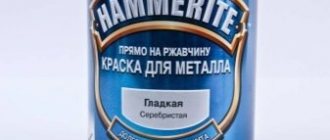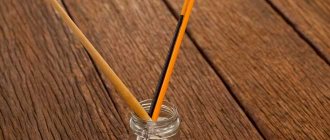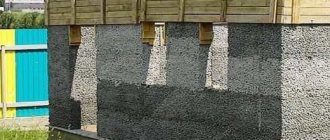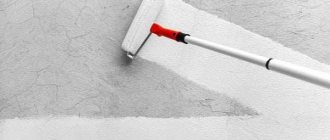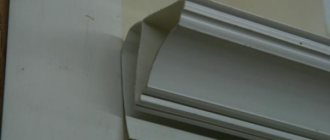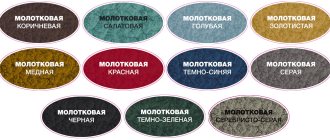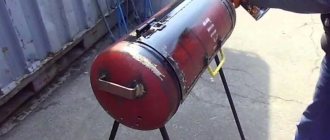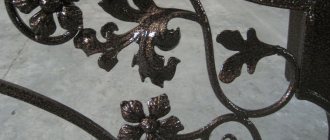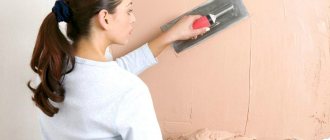Updated: 03/06/2021 13:12:47
Expert: Andrey Nikolaevich Kuznetsov
*Review of the best according to the editors of expertology.ru. About the selection criteria. This material is subjective in nature, does not constitute advertising and does not serve as a purchase guide. Before purchasing, consultation with a specialist is required.
In order for steel structures to maintain high strength for a long time, reliable protection against corrosion is required. Paint copes best with this task. The main problem when carrying out paint and varnish work is the preparation of the metal base. A lot of time and money goes into removing rust and old paint. Anti-rust paint allows you to reduce the cost of preparatory operations. Today, many effective paints and varnishes have appeared on the market. Our experts will help you choose the optimal product.
Hammer enamel painting technology
Before use, it is necessary to use a solvent to give it a working consistency.
Standard viscosity of the composition, with a nozzle with a diameter of 4 mm. is 24-25 seconds using a DIN3 viscometer. For dilution, use the following solvents:
- For the composition ML-165 - xylene;
- EP-1323ME - solvent No. 667 and No. 648;
- NTs-221 - solvent No. 646;
- Compositions Hammersmith - Rustbeater No. 1 solvent or Brush Cleaner (recommended by the manufacturer).
The approximate proportion for dilution is 2:1 (solvent paint). Painting with hammer paint is done using a roller. When completely repainting a car, it is rational to use a spray bottle, since it is impossible to apply a coating of uniform thickness to a large surface using a roller.
To properly adjust the supply pressure on the spray gun to a level of 2-2.5 atmospheres and set the spray pattern as wide as possible. If you do not have prior experience, practice painting third-party vertical surfaces, so you will determine the optimal distance for yourself between the spray gun and the body (the norm is 20-30 cm) and the speed of its movement.
Painting is carried out in a pre-prepared room - you need good lighting, a temperature of 20-25 degrees, no dust (when working in a garage, do a wet cleaning, if possible, blow off the floor and walls with compressed air).
Car preparation work consists of leveling out any irregularities found on the body and filling them with putty. Next, the surface is matted - the painted area is sanded to a rough state with sandpaper with a grain size of P80-100. After grouting, the body is cleaned of dust with a damp rag and degreased with a solvent (use a composition used for diluting enamel).
Hammer paint is applied in 3-4 layers, the interval between applications is 60 minutes (maximum pause time is 8 hours). Spraying is carried out in overlapping horizontal lines from a distance of 20-25 cm from the body. is 100 ml. per 1 m 2.
Types and manufacturers of hammer enamel
There are several types of such paint:
- Type ML 165 is suitable for decorating non-greasy surfaces. The advantages of this paint are durability and heat resistance (can withstand heat up to 130 C). The disadvantage is the ability to emit toxic fumes when applied.
- Hammerite hammer enamel for rust is an expensive, but very effective pleasure. This English-made paint will not only mask imperfections on the metal, but also protect the surface from oxidation. Thanks to special technology with the addition of wax, Hammerite enamel will provide protection against moisture and corrosion for up to 8 years. In addition, this paint contains silicone, which prevents the penetration of external contaminants and household chemicals. Hammerite paint products are quick-drying and can be used on metal without prior preparation.
- EP-1323ME enamel is suitable as a primer paint for metal. This type of paint is recommended for elements of cars, forklifts, as well as doors and all kinds of fences. You can also use this dye over rust.
- NTs-221 enamel is inexpensive, but its protective properties are quite high. This “budget” type of paint can be used exclusively indoors, since it is not capable of performing a protective function and has purely decorative properties. Under no circumstances should you apply this enamel over rust, and the heat resistance rating here is low.
- Hammer enamel "Molotex" is used in several areas at once - on rust, as decorative enamel or anti-corrosion primer. The product contains persistent pigments and synthetic varnishes that ideally hide defects in painted products and protect the surface from external influences. Available colors of this enamel: black, silver, dark green, brown, white and dark blue.
- Primer-enamel for rust 3in1 Dali is used for processing metal affected by pitting or continuous corrosion. Used on new or previously painted surfaces of stainless steel, cast iron, non-ferrous and galvanized metals, as well as wooden surfaces with a moisture content of less than 20%.
What is hammer paint for metal?
Recently, hammer enamel has become popular in landscape design, interior and exterior decoration. They talk a lot about this product, but they do not specify what hammer paint is, which is why many misconceptions arise. The key difference between the paint is its special texture; it cannot be confused with any other type, since after the surface hardens, it takes on a look similar to numerous blows from a hammer. Because of the specific effect, the substance acquired its name; sometimes it is also called blacksmith’s.
Hammer paint is one of the most durable compounds intended for metal processing.
Hammer effect paint is made from acrylic, alkyd-styrene and epoxy bases. To create a special appearance, aluminum powder, silicone oils and fine glass are added to the composition. Thanks to the presence of special silicone oils in the composition, it is possible to stabilize the texture and provide protection from water.
The best hammer paint for radiators
The composition includes special coloring pigments that create various visual effects. The painted surface looks like it has been beaten with a hammer. This texture in itself gives an original three-dimensional image and hides imperfections and defects on the surface of the radiators.
Certa-Plast
Hammer enamel for rust is used indoors and outdoors at temperatures from -60°C to +150°C. Available in 800 ml, 10 and 20 liter containers in different colors. It has high anti-corrosion properties, a primer effect and decorative characteristics, so the user does not need to carry out additional work to prepare the base for painting.
Certa-Plast
Can be applied using a roller, brush or spray gun. According to the manufacturer, the product has a service life of up to 10 liters. The cost of the product depends on the color and volume; a small container costs about 600 rubles.
Mister Hammer
Anti-corrosion enamel is produced using 3-in-1 technology, so it has several properties at once - decorative and protective. The material transforms rust, preventing it from developing and spreading over the rest of the surface.
Mr. Hammer
The main properties of the product are as follows:
- short drying time - up to three layers can be created in one day;
- unique pattern and structure when drying - creates an interesting relief surface;
- resistance to a humid environment, exposure to industrial oils, chemical components;
- the presence of corrosion neutralizers in the composition.
The material is successfully used for processing clean, rusty or previously painted steel structures, cast iron, or other non-ferrous metal products. Consumption varies within 120 g/m2. Drying to touch does not exceed half an hour, but complete drying requires 4 hours. Price – 650 rub./kg.
How Hammerite paint is applied to a metal surface
Before applying it, treating the surface with a primer is not a mandatory requirement. But you can do this if you wish. The effect of paint adhesion to metal will only increase. To do this, use Hammerite No. 1 Anti-Rust.
If there are areas of well-adhering old paint remaining on the surface, do the following. Apply Hamerite to a test spot. Let dry for 30 minutes and inspect. If the coating is intact and even, then the composition of the previous paint allows you to apply a new one on it.
Hammerite colors
The composition is applied to the surface in the following basic ways:
- brush or roller for painting;
- using aerosol paint in a special can;
- using air spray (compressor with spray gun).
Let's consider the features of using each method.
The first is using a brush, when Hamerite paint is applied to medium-sized surfaces and to objects with complex elements and shapes.
- Assess the viscosity of the paint before use. As a rule, no additional dilution is required. If it thickens, it needs to be diluted. To do this, add 1 part Hammerite Brush Cleaner & Thinners to 9 parts paint and mix thoroughly.
- Use good quality brushes made from natural bristles. This will ensure uniform coating application on the first pass. Do not use brushes whose bristles remain on the surface during the painting process.
- Dip your brush into Hammerite paint no more than half the size of your work surface. This will make it possible to use paint sparingly and without smudges.
Applying Hammerite paint with a brush
Make movements with the brush preferably in one direction, overlapping each subsequent stroke by half with the previous one. This will ensure uniform paint application. Be sure to thoroughly apply Hammerite to areas of the product being painted where access is inconvenient and difficult. This is your area of special attention.
Painting is carried out in no less than 2 and no more than 3 layers. One coat of paint will not provide the desired effect. Applying more than 3 layers will lead to unnecessary consumption of paint material. Painting vertical metal surfaces requires special attention. This is due to the fact that, being at such an angle, the applied paint can flow down and form smudges. Constantly monitor the condition of previously applied layers. If necessary, without allowing them to dry, immediately correct this area of the surface with a brush. Before applying the next layer, it is necessary to wait at least 3 hours for the previous one to dry. There is no need to rush. This will lead to the destruction of the previously applied coating.
Part painted with Hammerite paint
The second is using a roller. The basic requirements for preparing the paint composition remain the same as when using a paint brush.
Features include the method of dipping the roller into a special container for applying paint to its working surface. Do this evenly over its entire fleecy part. Carrying out such an operation will ensure that the Hamerite composition is applied evenly and without gaps.
Painting with a roller
The third is by air spray. The paint composition is applied from an aerosol can or with a compressor and spray gun.
Large areas are painted using a compressor and a spray gun. In this case, it is mandatory to comply with the paint viscosity requirements. It is necessary to prepare the composition in a ratio of 2 parts paint and 1 part Hammerite Brush Cleaner & Thinners. If this ratio is violated, the spraying process will be difficult or impossible. A thick composition will not spray normally from the spray gun nozzle. Excessively thinned will produce smudges or an unacceptably thin layer of coating.
Applying paint using air spray
The paint is applied in 3-4 layers with breaks between applications of 30 minutes.
How to paint and how to dilute
Before you paint the desired surface, you should figure out what method will be used to carry out this process. The work can be done with a brush, pneumatic sprayer or roller. You can also purchase the material in a can, which does not require the use of additional equipment. One layer must be thicker than 100 microns; this is the only way to achieve high performance parameters.
Aerosols are good if you need to treat a small area. In large-scale works, it is better to give preference to a canned mixture and a spray gun. Next, read the manufacturer's instructions on how to dilute the hammer paint and in what quantity to obtain the desired consistency. As a rule, the mixture is diluted with dissolve in a 2:1 ratio.
In the case of the airless application method for painting gates, large metal structures or car bodies, the dye is mixed with a 9:1 solvent. Approximately, the material consumption varies within 100 ml/m2, but this parameter can vary depending on the thickness, number of layers, and absorbency of the base.
Application steps:
- Preparatory work. Remove lubricants from the part. To improve the protective effect, remove old paintwork and rust using a wire brush. This will increase adhesion. Wash the product with washing powder and dry thoroughly. Galvanized, wood and aluminum parts are treated with a primer.
- The first layer is applied. Dilute part of the material with solvent in a ratio of 1:9. Apply the mixture first to corners, edges and other areas where there is a complex structure. Use a brush here. Next, cover the main part using a roller.
- The second layer and all subsequent ones. When creating subsequent layers, the enamel can be applied without dilution. The work is carried out according to the stages of the previous paragraph, first the relief areas are painted, then the flat surface.
VIDEO: How to paint with hammer paint correctly
Advantages and disadvantages
In search of high-quality and attractive paint, every consumer strives to find the ideal option that will delight him with its wear resistance and durability. The original hammer mixture meets these requirements.
In addition, such coloring compositions have many other advantages that make them popular and in demand:
- Hammer paint is not afraid of temperature changes. Neither hot summer, nor frosty winter, nor rainy autumn will affect its appearance and performance characteristics.
- Hammer effect enamel can be applied to surfaces covered with rust. Moreover, for this it is not at all necessary to prepare the bases and treat them with a primer.
- Hammer mixtures dry out fairly quickly.
- Such paint and varnish coatings are not afraid of dampness and moisture.
- High-quality hammer paints protect metal substrates from rusting outdoors for up to 8 years. Not every enamel can boast of this characteristic.
- This enamel can be purchased for both interior and exterior finishing work.
- Hammer effect paint is not subject to mechanical damage. Thanks to this characteristic, it will be very difficult to leave a scratch or other damage on such a coating.
- This paint and varnish composition is safe for health. It does not release hazardous substances either during application or after drying.
- It is impossible not to note the decorative properties of such paint. It is presented in a very rich color palette. Over time, hammer mixtures do not fade when exposed to sunlight.
- Hammer paint does not have an unpleasant odor.
- The dried hammer surface has an interesting ability - it repels water, dirt, and dust. That is why the objects on which it is applied look well-groomed.
- Thanks to its characteristic texture, hammer paint is able to hide minor imperfections in the base. If there is a noticeable chip on it, then it can be painted over locally. In this case, the tinted area will not be noticeable.
As you can see, hammer paint has a considerable list of positive qualities.
However, it also has its weaknesses:
- Removing such paintwork from any surface is not an easy task. To do this, it is necessary to use aggressive solvents and abrasive tools. However, even with such devices it will be difficult to remove a layer of paint.
- If you are hammer painting a metal base, you need to make sure that no area is left unpainted. Otherwise, corrosion will quickly appear in the unfinished area, which will eventually spread to the coating itself.
- Applying such paint with a spray gun (or using a can or spray) is very difficult, since it is characterized by increased thickness and density.
- Many consumers consider the high cost of hammer paint to be a disadvantage. Moreover, it is characterized by high consumption, so there is no need to talk about its availability.
How to choose paint for rust
- Kinds
. All paints and varnishes consist of a base substance, which is taken as the basis for classification. - Epoxy paint
is a two-component composition. It is suitable for coating metal parts that are exposed to heat. But due to toxicity, the product is not recommended for household use. - Oily
consists of a natural base (oil) and drying oil. It does not have anti-corrosion properties, so its scope of application is limited to interior spaces. - Alkyd
is excellent for galvanized steel. It has good adhesion, but is prone to fire. - Acrylic enamel
stands out for its long-term protection of metal from corrosion. It is not afraid of temperature changes, so experts recommend the product for painting heating systems. - The hammer
forms a rough coating. The name itself suggests that the paint layer is uneven, as if a hammer had been passed over the surface. But this coating looks modern, and it also hides defects in the base. - Three-component paint
. To facilitate the work associated with removing corrosion on old metal structures, three-component paints were invented. The 3 in 1 material consists of a rust converter, primer and finishing enamel. A distinctive feature of this paint is its high adhesion. In addition, the material resists rust, moisture, ultraviolet radiation and temperature changes for a long time. Three-component paints are versatile, suitable for both indoor and outdoor use. - Features of paint application
. In order for the paintwork to remain durable and intact for a long time, it is important to properly prepare the base. Even when using three-component paint, loose rust, dust, dirt and traces of grease must be removed. The paint can be applied using a brush, roller or spray gun. The air temperature should be positive; few paints can be applied in cold weather. When creating a multi-layer coating, it is important to take the time interval after applying each layer specified by the manufacturer.
We have selected the 5 best rust paints for review. All of them are widely represented in Russian stores. When distributing places in the rating, the opinion of experts and reviews of domestic consumers were taken into account.
"Pros" and "cons" of using paint
Like any product, this paint is endowed with positive properties, but also has negative aspects. The advantages include the following:
To paint the surface, you need to make a minimum of preparation; For painting you need a minimum of tools, including just one stripper; Any beginner can handle the processing process; you don’t have to pay for the services of specialists; It takes only three hours for the layers to dry, which will significantly affect the repair work; Obtaining a water-repellent and dirt-repellent coating is possible thanks to the silicone included in the composition; Prevents the appearance of rusty areas; Any surface structure that is selected from the proposed range - matte, semi-matte, glossy - will look attractive on the surface; No harmful or unpleasant odor, which is especially important when you have to work inside a building.
The negative side is the inadmissibility of covering a surface that has a layer of bitumen paint.
If it is not possible to determine what material was used previously, then you should paint a small area with paint and wait for the material to react. There should be no swelling or cracks on the surface.
It takes only three hours for the layers to dry, which will significantly affect the repair work.
The best hammer paint for gates and metal doors
High coefficient of anti-corrosion protection. Contains silicone resins and metal pigments, which increase the density of the paint itself and increase the strength of the metal
Molotex
This is a decorative blacksmith-type enamel for processing any metal products, including doors. The product acts as a suspension of corrosion-resistant pigments, as well as fillers with admixtures of additional strengtheners. The product combines a corrosion converter, a primer, and a decorative dye.
Molotex
The material comes in the following colors:
- brown;
- grey;
- silver;
- green;
- blue;
- black.
Thanks to the relief structure that results from hardening, the mixture successfully hides all the unevenness of the base. The product is sold in containers of 800 ml, 2.5 kg and 17 kg. The cost for the minimum volume does not exceed 550 rubles.
How to paint a metal door with hammer paint
Hammer paint works well for painting metal doors and gates. This paint has a special texture when it dries - the result is a surface with an interesting visual effect, as if it had been beaten with a hammer. Hammer paint has stable anti-corrosion properties; it contains special silicone resins and metal pigments, which increase its density and increase resistance to external influences.
Benefits of hammer paint
- No preliminary preparation of the surface to be painted is required. The paint already contains primers, which facilitates and improves the painting process when there is no time or opportunity to thoroughly clean the surface of the doors from old rust.
- Hammer paint is corrosion resistant and dries quickly.
- The color of the products does not change and does not lose its saturation for quite a long time.
- The dyeing technology is simple and convenient.
- Beautiful aesthetic appearance. Hammer effect paint comes in a variety of shades that will help improve the appearance of metal doors. Forged gates look very impressive and textured when hammer paint is used to paint artistic forging elements.
- Hammer paint has the useful property of repelling dirt and dust - painted products always look neat and do not require special care.
How to paint metal gates with hammer paint
To prevent garage doors from rusting, their surface must be painted with corrosion-resistant paint. The optimal solution for protecting metal surfaces from rust is painting with hammer paint.
The technology for painting metal doors with hammer effect paint is not at all complicated.
- Remains of old paint are removed from the canvas using a metal brush or an electric drill with a special attachment.
- The surface of the metal door is thoroughly cleaned with acetone.
- Hammer paint contains primers, but for a better painting effect, the surface of garage doors is primed.
- Paint the gate using a roller or spray. A paint brush is not suitable for painting a wide surface - with its help it is very difficult to achieve a uniform layer of paint and the absence of streaks or smudges.
How to properly paint a metal door with a roller
Roller painting is effective for large, smooth, flat surfaces.
Before starting to paint a metal surface, to apply the first layer, hammer paint is diluted in a ratio of ten parts paint to one part solvent. The next layer does not need to be thinned. For work it is better to use a medium-sized roller. First, paint is applied to the corners and edges of the doors using a small brush, and then the remaining surface area is painted with a roller. One layer will not be enough - the protective properties of a single-layer coating are not as effective as when painting in several layers. The decorative effect also deteriorates - if the paint layer is too thin, then bubbles may form on the dried painted surface. To avoid this, apply an additional layer of paint. The next layer must be applied at least half an hour later, waiting for the first layer to set a little on the surface. If necessary, apply another layer of hammer paint.
Technology of painting hammer paint using a paint brush
A brush for painting the surface with hammer paint is used on complex shaped configurations where detailed and fine painting is required. It is recommended to use brushes with natural bristles. It is not necessary to dilute hammer paint when painting with a brush.
The best hammer paint for cars
If you want to get “candy,” the body is first cleaned to a metallic shine. Dents and deep scratches are puttied and then rubbed (matted) with fine sandpaper. Be sure to degrease the surface with gasoline or solvent. Then the paint is diluted with Solvent if it is very thick. They can also be used to wipe away the stains afterwards. Apply with a brush with natural bristles - the artificial one will simply dissolve. The hammer effect does not appear immediately - after 30 minutes, after the first layer you need to leave it for 4 hours to dry. Ideally there should be at least 3 layers.
Kudo KU
These are products from a domestic manufacturer, which are packaged in a 520 ml bottle with a sprayer. The alkyd mixture has good covering ability. In addition, it neutralizes the formation and spread of corrosion.
Kudo KU
Thanks to special fillers and silicone, the material is used to coat wood substrates, elements made of ferrous metals or plastic. 3 in 1 production technology reduces the time spent on preparing the base. External and internal use is possible. The price for a 520 ml cylinder is 190-230 rubles.
BOSNY Hammer
Aerosol paint is made on the basis of synthetic resins. Can be used indoors and outdoors. After drying, the layer takes on a plastic appearance with a relief surface. The product can be applied not only to the car body, but also with equal success to any steel products.
BOSNY Hammer
Requires thorough shaking before use. The color palette contains all the basic shades. The cost of a 400 ml aerosol can is 210 rubles.
Peculiarities
Today, hammer paint is very popular because it has anti-corrosion properties. In addition, she is not afraid of negative external factors. Hammer paint is not afraid of rain and snowfall, so it is often used to decorate building facades.
Under the influence of temperature changes, such wear-resistant paint does not crack and does not lose color saturation. That is why it is used not only to decorate certain bases, but also to protect them from various external influences.
The secret of such resistance to wear lies in the composition of the hammer paint. It contains special polymer resins that adhere particularly well to metal surfaces. Moreover, they protect them from corrosion and extend their service life. In addition to polymer resins, this wear-resistant paint mixture contains acrylic and alkyd components.
In addition, hammer paints are often mixed with silicone oil, epoxy resins and complex fillers, such as aluminum powder or fine glass. The listed components not only make the coating high-quality and durable, but also provide it with increased adhesion, so hammer paint can be applied to almost any surface without any problems.
However, due to its excessive density, it is unlikely to be possible to apply such paint with a sprayer. Initially, such coloring mixtures were produced only in gray. When they began to be used to decorate various bases, manufacturers added pigments of different colors to their composition. Today in stores you can find reliable hammer paint of any shade.
This paint looks very unusual on certain surfaces. It not only has an interesting shine and unusual texture, but also forms small potholes, which is why it is often confused with a powder mixture applied in special hermetic chambers. Real, high-quality hammer-effect paint is sold in ordinary cans and does not need to be diluted, as it is initially ready for finishing work. Hammer paint is quite easy to work with. Even an inexperienced home craftsman can handle this without any problems.
Unfortunately, today in stores there are a lot of fake hammer paints that are not of high quality. They often contain branded stickers, which are trusted by many consumers.
Features of use
The main feature of Hammer metal paint is that it does not require mechanical preparation of the surface.
The work stage, which includes processing with sandpaper or a grinder, can be eliminated; it is permissible to apply Hammerite directly to the rust. It is only important to rid the surface of all kinds of fats - this can be done using a solvent or gasoline.
Hammer paint has another important advantage - there is no need to prime the surface, which makes it possible to significantly reduce the time required for preparation. This is especially convenient when painting a car. Since in case of damage to the surface of the body, you should paint it over as quickly as possible, so as not to give rust any chance to appear.
When painting with Hamerite, you should remember safety precautions. Since hammer paint can cause poisoning if it enters the human body, it is toxic. Therefore, while working, it is advisable to use special glasses and a respirator, which will protect your health.
Hamerite can be used to protect and decorate a wide variety of surfaces. According to the manufacturer, this unique paint is excellent not only for working on metal, but also for processing:
- wood;
- plastic;
- glass
Despite the fact that Hammer paint does not require surface preparation, if it is pre-coated with a primer, the metal will be protected much more reliably.
Therefore, if possible, you should go over the rust with a special brush or grinder - although this is not necessary. This is especially true for car body parts. Thus, the service life of the product can be made much longer.
Painting car bodies or other surfaces can be done using a variety of tools. Hammerite can be applied well using:
- brushes;
- roller;
- spray gun.
Painting can only be carried out at positive temperatures, it should not be less than +50 C. Otherwise, Hammerite simply will not be able to “grab” the car body or other metal product. You should also remember the maximum temperature - the use of Hammerite is permissible only if it is no more than +300 C.
When painting is completed, you only need to wait 2 hours. After this time, Hammerite will have dried so much that it will not stick to the touch. This is especially important when applying it to the surface of a car body - the quick-drying composition allows you to paint as quickly as possible. The drying time is not affected in any way by the type of surface being painted. Reviews about this corrosion protection product are only positive, partly due to the speed of its drying.
Varieties
Hammer effect paint is divided into the following types:
- Nitroenamel "NTs-221" is considered the cheapest, since it serves only as a decorative coating. Therefore, it is used for interior work. It is afraid of high humidity and is susceptible to corrosion.
- Hammer enamel “ML-165” has an alkyd-styrene base. Withstands the highest temperatures, up to +130 degrees. Has a high degree of adhesion to any material. Used for external and internal work. Can be painted even over rust.
- Epoxy enamel “EP-1323” performs the function of a dye and a primer at the same time. It has thermal and anti-corrosion properties. Designed for cars, gates, artistic forging, etc.
- Hammerite enamel is considered the most expensive. Manufacturer – UK. When painting with it, an additional primer is applied. After drying, a film is formed that protects the metal from oxidation. Made from silicone additives and alkyd resins. Feature – it is not advisable to paint with a spray gun. Used everywhere, even on top of rust.
Advantages
Among the advantages of hammer paint:
- high degree of resistance to temperature changes;
- anti-corrosion;
- possibility of application directly to rust;
- quick drying, especially if the paint is aerosol;
- moisture resistance;
- reliable protection against rust for 8 years;
- coating strength;
- no toxic evaporation after drying;
- harmless to the body even when used indoors;
- large selection of colors;
- unusual decorative effect;
- repels dust and dirt;
- water-repellent properties;
- smoothing out surface irregularities;
- if there are chips, there is no need to remove the entire layer of paint; it is enough to cover it with enamel in the area of the defect;
- immunity to vibration, which is why hammer paint is used for cars;
- absence of unpleasant odors;
- Possibility of painting with different tools.
Main characteristics and features of the coating
The results and characteristics of the paint composition may differ from one manufacturer to another, but for the most part, hammer paints have similar features:
- Alkyd resin is used for the binder.
- The density of the substance is 1 kg/l.
- The coating residue on the surface is 47%.
- Drying time parameters: at least two hours.
- If it is necessary to apply several layers, then each subsequent one is applied 5 hours after the previous one.
- Shelf life in containers is 2 years, provided all storage rules are followed.
- Gloss level indicators - 66.
- Withstands temperatures up to +80°C.
- To apply one layer, you need to use a liter of hammer dye per 10 m2.
Among the main advantages of the paints in question, there are several of the most attractive:
- there is no need to clean the entire surface of rust before use;
- the coating tolerates vibration and many atmospheric phenomena;
- paint helps protect metal from rust;
- re-painting of the metal structure may not be necessary for 10 years;
- the paint does not contain toxic elements that adversely affect human health;
- the coating does not have a strong and pungent unpleasant odor, which facilitates the use of the substance even in poorly ventilated areas;
- the coating has a wide variety of shades, which makes the choice very rich;
- the paint does not fade for a long time;
- Dirt and dust do not stick to this coating.
The only drawback is that old paint is very difficult to remove from the painted surface. In some cases, even a strong solvent does not help.
Application area
Hammer effect coating is a widely used material for painting a wide variety of metal surfaces. It looks especially chic on forged products. In addition, paint with a hammer effect is used:
- For painting machinery, as well as various equipment.
- Metal pipes.
- Painting of main components in various types of structures.
- Glass surfaces.
- Fences and fences made of appropriate material.
On the street, this coating is often used specifically for painting fences and other metal structures. They will be able to stand for a huge amount of time and not change their appearance.
Surface preparation
In order for the surface to last as long as possible with the new coating, it must be properly prepared. First of all, the surface is pre-wiped with acetone. To test for doneness, it’s easy to use a thin sheet of plain paper. If you run it over the surface and there are no traces left, the product is ready for painting.
In order to better prepare the surface for painting, it is advisable to treat it with an iron brush. After such cleaning, surface adhesion improves.
The next step is to treat the surface to be painted with a primer. It will create a special film on which the paint will adhere in an even and durable layer.
Advantages
Hammerite hammer paint has many advantages. The main ones are:
- no need to carry out preparatory work;
- hammer paint has a distinctive appearance;
- Hamerite can be used both outside and inside the home;
- the palette is very diverse.
Hammer paint contains aluminum flakes or other additives that give the painted surface the appearance of being hit with a hammer. That is why the paint is called “hammer paint”.
Hamerite staining is often used to create an aged effect on various metal surfaces. For example, wrought iron benches and metal chairs are often coated with Hammerite. This makes it possible to use them in various styles such as “Provence” or other similar ones.
Despite the fact that Hammerite contains substances that are toxic to humans, after drying the paint becomes completely harmless. Therefore, hammer enamel is often used to decorate any objects inside residential premises. Again, they can be all kinds of stools, forged tables and other metal interior elements. This is helped by the fact that Hammerite is a typical hammer paint. It can give an unusual and antique look to even the most ordinary item.
Another advantage is the different colors - you can find Hammerite of any shade on sale. This allows finishing work to be carried out using Hammer enamel of various kinds. Hammerite comes not only in hammer type, but also in glossy and matte finishes. A wide variety of colors and textures are available.
Thus, when using Hamerite, the surface can be hammered or, conversely, glossy. Sometimes you can find Hammerite primer on sale. It does not have any decorative properties; it only protects the metal from exposure to water. Therefore, it is quite often used to prepare for painting a car. Hammerite is used not only for decoration, but also for protecting surfaces.
Hammerite is economical - for 10 square meters it usually takes no more than 1 liter - if painting is carried out in one layer. Therefore, to prime a car you will need a relatively small amount of Hammerite. Moreover, it does not matter at all what is being painted – rusty metal or some other material. Reviews about Hamerite from consumers are mostly positive.
Hammerite, intended for rust staining, has an interesting feature. With its relatively low viscosity, it sprays very easily. But the occurrence of drips is practically excluded - which is especially important when applying this composition to a car. Painting with a spray gun can be carried out even in the presence of wind. The surface will be covered with a compound called Hammer in an even layer. The need for repainting is completely eliminated.

